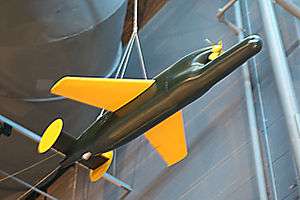Henschel Hs 298
The Henschel Hs 298 was a 1940s German rocket-powered air-to-air missile designed by Professor Herbert Wagner of Henschel.[1]
| Henschel Hs 298 | |
|---|---|
 | |
| Role | Rocket-powered air-to-air missile |
| National origin | Germany |
| Manufacturer | Henschel |
| Designer | Herbert A. Wagner |
| First flight | 22 December 1944 |
Design and development
The Hs 298 was designed specifically to attack Allied bomber aircraft and was the first missile designed specifically for air-to-air use.[1] It was to be carried on special launch rails by Dornier Do 217s (five missiles) or Focke-Wulf Fw 190s (two missiles) and carried 48 kg (106 lb) of explosive,[1] slightly more than the 40.8 kg warheads carried by unguided BR 21 heavy-calibre air-launched rockets in use from the spring of 1943 onwards.
The Hs 298 was a mid-wing monoplane with tapered swept back wings and it had a single horizontal stabiliser with twin vertical fins.[1] It was powered by a Henschel-designed rocket motor built by Schmidding as the 109–543; it had two stages, the first high velocity stage was designed to leave the launch aircraft at 938 km/h (585 mph), in the second stage the speed was brought back to 682 km/h (425 mph) to give a maximum range of about 1.5 km (0.93 mi).[1] It used a Kehl-Straßburg MCLOS radio guidance system (the Funkgerät FuG 203-series Kehl transmitter in the launching aircraft, the FuG 230 Straßburg receiver in the ordnance) powered by a propeller-driven (mounted on the nose) electric generator.[1] The missile needed two crew on the launch aircraft to control it, one operator used a reflector-type sight to aim at the target and the other flew the missile using a joystick on the Kehl transmitter, and another sight paired to the first with a servo system.[1]
The only known test firings were carried out on 22 December 1944 with three missiles carried by a Junkers Ju 88G.[1] Only two missiles left the launch rails with one failing to release, of the two released one exploded prematurely and nose-dived into the ground.[1] It was planned to enter mass production in January 1945 but the project was abandoned in favour of the X-4.[1]
Survivors
One Hs 298 is on display at the Royal Air Force Museum Cosford.[1] One Hs 298 is on display at the Smithsonian National Air and Space Museum Steven F. Udvar-Hazy Center.
Specifications
- Wing span – 1.24m (4 ft 1in)
- Length – 2.06m (6 ft 9in)
- Launch weight – 120 kg (265 lb)
- Launch speed – 938 km/h (585 mph)
- Cruise speed – 682 km/h (425 mph)
References
| Wikimedia Commons has media related to Henschel Hs298. |
- Royal Air Force Museum Cosford Guidebook, 1976